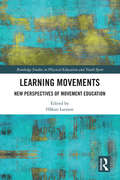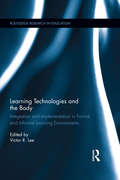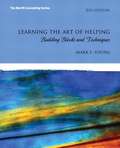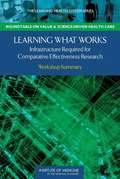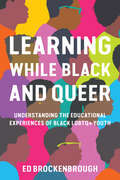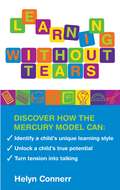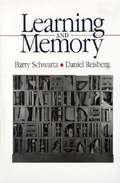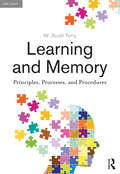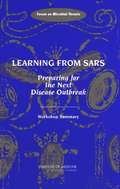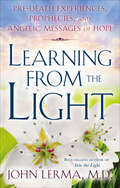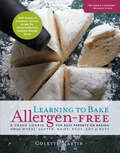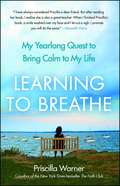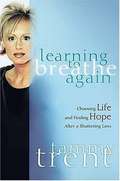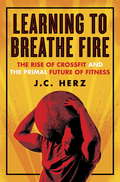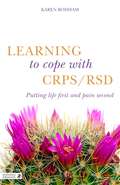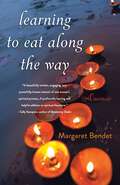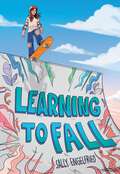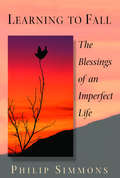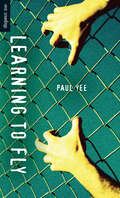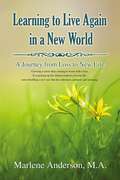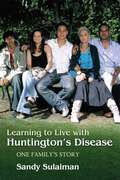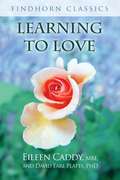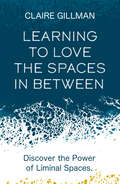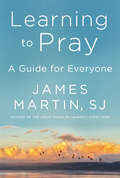- Table View
- List View
Learning Movements: New Perspectives of Movement Education (Routledge Studies in Physical Education and Youth Sport)
by Håkan LarssonContemporary ways of understanding human movements, specifically movement learning, are heavily dominated by individualistic, dualistic and mechanistic perspectives. These perspectives are individualistic in the sense that in research as well as in educational practice movements/movers are typically decontextualized, they are dualistic in the sense that the body is taken to be ‘inhabited’, even ‘governed,’ by a rational mind which is not itself a part of that body; and they are mechanistic in the sense that movements and movement learning can be ‘calculated’. This approach has supported the dominance of a westernised and predominantly white, masculinised and heteronormative view of able bodies, embodiment and movements. Hence, it has contributed to marginalise not only other approaches and perspectives and individuals. New research has evolved, including new approaches and these held perspectives have been challenged by social and culturally sensitive, holistic as well as pluralistic, and dynamic/organic perspectives of human movements and moving humans. Examples of such research can be found in disciplines such as; physical education and pedagogy, ethnography, philosophy, and sociology. Learning Movements: New Perspectives of Movement Education provides the societal and epistemological background for these new approaches and will be essential in disseminating this knowledge to movement educators, academics and researchers as well as professionals within education, sports, health and fitness, dance, outdoor activities, etc., and that it will spearhead new and inclusive practices within these settings.
Learning Technologies and the Body: Integration and Implementation In Formal and Informal Learning Environments (Routledge Research in Education #135)
by Victor R. LeeThis volume explores how technology-supported learning environments can incorporate physical activity and interactive experiences in formal education. It presents cutting-edge research and design work on a new generation of "body-centric" technologies such as wearable body sensors, GPS tracking devices, interactive display surfaces, video game controller devices, and humanlike avatars. Contributors discuss how and why each of these technologies can be used in service of learning within K-12 classrooms and at home, in museums and online. Citing examples of empirical evidence and specific implementation, this timely and critical volume examines how body responsive technologies are being used within the educational community to advance the next generation of educational technology.
Learning The Art of Helping: Building Blocks and Techniques (5th Edition)
by Mark E. YoungThis best-selling resource is a great refresher and hands-on resource for counselors new to their professions. It's packed with step-by-step guidance for developing the skills and techniques they need to effectively help their clients. It covers not just the basic building blocks in the profession, but also what the author calls the "megaskills" and common curative factors that lie behind the methods. The tone is conversational and the references are very useful.
Learning What Works: Workshop Summary
by J. Michael Mcginnis Leighanne Olsen Claudia GrossmanThis collection of essays, drawn from the Institute of Medicine's Round Table on Value and Science-Driven Health Care, presents current scholarship in the development of infrastructure and methodologies for improving health system frameworks in the coming decades. Topics discussed include infrastructure; training and personnel; advanced technologies and communications; and policy, priories and implementations of a value driven agenda. Contributors are executive level health policy professionals. Annotation ©2012 Book News, Inc. , Portland, OR (booknews. com)
Learning While Black and Queer: Understanding the Educational Experiences of Black LGBTQ+ Youth
by Ed BrockenbroughResearch-based guidance for educators, teacher educators, and community learning partners to effectively support LGBTQ+ students of color
Learning Without Tears
by Helyn ConnerrA collection of gluten-free and dairy-free recipes, showing how you can avoid these ingredients while enjoying healthy food. This book contains 200 recipes, including: soups, salads, fish, vegetarian dishes and others. It provides information on the differences between classical allergy and intolerance, and diagnosis and treatment of allergies.
Learning and Memory 1st Edition
by Barry Schwartz Daniel ReisbergThis book illustrates how various topics in learning and memory are related.
Learning and Memory: Basic Principles, Processes, and Procedures (Fifth Edition)
by W. Scott Terry<p>This thoroughly updated edition provides a balanced review of the core methods and the latest research on animal learning and human memory. The relevance of basic principles is highlighted throughout via everyday examples to ignite student interest, along with more traditional examples from human and animal laboratory studies. Individual differences in age, gender, learning style, cultural background, or special abilities (such as the math gifted) are highlighted within each chapter to help students see how the principles may be generalized to other subject populations. <p>The basic processes of learning – such as classical and instrumental conditioning and encoding and storage in long-term memory in addition to implicit memory, spatial learning, and remembering in the world outside the laboratory – are reviewed. The general rules of learning are described along with the exceptions, limitations, and best applications of these rules. The relationship between the fields of neuropsychology and learning and memory is stressed throughout. <p>The relevance of this research to other disciplines is reflected in the tone of the writing and is demonstrated through a variety of examples from education, neuropsychology, rehabilitation, psychiatry, nursing and medicine, I/O and consumer psychology, and animal behavior. <p>Each chapter begins with an outline and concludes with a detailed summary. A website for instructors and students accompanies the book. Updated throughout with new research findings and examples the new edition features: <p> <li>A streamlined presentation for today’s busy students. As in the past, the author supports each concept with a research example and real-life application, but the duplicate example or application now appears on the website so instructors can use the additional material to illustrate the concepts in class. <li>Expanded coverage of neuroscience that reflects the current research of the field including aversive conditioning (Ch. 5) and animal working memory (Ch. 8). <li>More examples of research on student learning that use the same variables discussed in the chapter, but applies them in a classroom or student’s study environment. This includes research that applies encoding techniques to student learning, for example: studying: recommendations from experts (Ch. 1); the benefits of testing (Ch. 9); and Joshua Foer’s Moonwalking with Einstein, on his quest to become a memory expert (Ch. 6). <li>More coverage of unconscious learning and knowledge (Ch. 11). <li>Increased coverage of reinforcement and addiction (Ch. 4), causal and language learning (Ch. 6), working memory (WM) and the effects of training on WM, and the comparative evolution of WM in different species (Ch. 8), and genetics and learning (Ch. 12).</li>
Learning from SARS: Preparing for the Next Disease Outbreak
by Forum on Microbial ThreatsThe emergence of severe acute respiratory syndrome (SARS) in late 2002 and 2003 challenged the global public health community to confront a novel epidemic that spread rapidly from its origins in southern China until it had reached more than 25 other countries within a matter of months. In addition to the number of patients infected with the SARS virus, the disease had profound economic and political repercussions in many of the affected regions. Recent reports of isolated new SARS cases and a fear that the disease could reemerge and spread have put public health officials on high alert for any indications of possible new outbreaks. This report examines the response to SARS by public health systems in individual countries, the biology of the SARS coronavirus and related coronaviruses in animals, the economic and political fallout of the SARS epidemic, quarantine law and other public health measures that apply to combating infectious diseases, and the role of international organizations and scientific cooperation in halting the spread of SARS. The report provides an illuminating survey of findings from the epidemic, along with an assessment of what might be needed in order to contain any future outbreaks of SARS or other emerging infections.
Learning from the Light: Pre-Death Experiences, Prophecies, and Angelic Messages of Hope
by John LermaA hospice doctor shares stories from his patients and their loved ones about transitioning to the next world and lessons we can learn from them.John Lerma’s bestselling book, Into the Light, inspired thousands of readers to discover not only what awaits us as we prepare to make our journey from earth to heaven, but, more importantly, how to achieve heaven on earth. Now in Learning from the Light, Dr. Lerma shares more angelic messages given to his patients and more stories from and about survivors who have experienced the loss of a loved one . . . and their visits with angels.The mystical experiences described in this revelatory work include:Messages about the future of the worldLessons on how to prepare for a peaceful and joyful transition to the next worldSelfless suffering and its effect on humanityElectronic voice phenomena (EVP)Interactions with white angels and dark angelsBased on the latest research on near-death and pre-death experiences, Learning from the Light will show you:How to achieve heaven on earthHow to achieve self-forgiveness and self-loveHow to disconnect from your ego to awaken your spiritual selfReligious skeptics often claim that heaven’s existence cannot be proven, because no one has ever returned to talk about it firsthand. This is the book that proves them wrong.Praise for Learning from the Light“With beautifully heartfelt sensitivity, Dr. John Lerma brings the truest accounts of life beyond death and the freedom that accompanies the dying process. No one can read this book without experiencing a smile, a tear, or embracing the possibility . . . no the reality that death is not an end but a reunion with our truest nature.” —Meg Blackburn Losey, PhD, author of the international bestseller The Children of Now“After journeying through three near-death experiences of my own, I can validate what Dr. Lerma has learned from his patients, in the process of transition. I highly recommend this book to everyone who wonders if there is life after death.” —Dannion Brinkley, author of Saved by the Light, At Peace in the Light, and Secrets of the Light
Learning to Bake Allergen-Free: A Crash Course For Busy Parents On Baking Without Wheat, Gluten, Dairy, Eggs, Soy Or Nuts
by Colette MartinA crash course for busy parents on baking without wheat, gluten, dairy, eggs, soy, or nuts Has your child been diagnosed with food allergies? If so, help is here! Colette Martin has been there too: When her son Patrick was diagnosed with multiple food allergies in 2001, she had to learn all-new ways to feed him—and especially to make baked goods that he both could and would eat. Learning to Bake Allergen-Free is the book Colette Martin wishes she had back then. She ingeniously presents a dozen manageable lessons that will arm parents to prepare allergen-free baked goods the entire family can enjoy together. The book features: • More than 70 recipes (including variations) sure to become family staples—for muffins, rolls, breads, cookies, bars, scones, cakes, tarts, pizza, and pies— starting with the easiest techniques and adding new skills along the way • Clear explanations of the most common allergens and gluten, with all the details you need on which substitutions work, and why • Hundreds of simple tips for adapting recipes and troubleshooting as you go • Detailed guidelines and more than 15 recipes for making allergen-free treats from packaged gluten-free baking mixes • Special crash courses focused on key ingredients and techniques, including sweetening options, decorating a cake simply but superbly, kicking everyday recipes up a notch, and much more! Whether you already love to bake or are a kitchen novice, Learning to Bake Allergen-Free will give you the knowledge, skills, recipes, and confidence to make food that your family can safely eat—and that they’ll love!
Learning to Breathe
by Priscilla WarnerPriscilla Warner has had a great life: a supportive husband, a flourishing marriage, two loving sons, and a bestselling book, The Faith Club. Despite all her good fortune and success, she suffers from anxiety and panic attacks so debilitating that they leave her unable to breathe. She's tried self-medicating--in high school, with a hidden flask of vodka--and later, with prescription medications--daily doses of Klonopin with a dark-chocolate chaser. After forty years of hyperventilating, and an overwhelming panic attack that's the ultimate wake-up call, Warner's mantra becomes "Neurotic, Heal Thyself." A spirited New Yorker, she sets out to find her inner Tibetan monk by meditating every day, aiming to rewire her brain and her body and mend her frayed nerves. On this winding path from panic to peace, with its hairpin emotional curves and breathtaking drops, she also delves into a wide range of spiritual and alternative health practices, some serious and some . . . not so much. Warner tries spiritual chanting, meditative painting, immersion in a Jewish ritual bath, and quasi-hallucinogenic Ayurvedic oil treatments. She encounters mystical rabbis who teach her Kabbalistic lessons, attends silent retreats with compassionate Buddhist mentors, and gains insights from the spiritual leaders, healers, and therapists she meets. Meditating in malls instead of monasteries, Warner becomes a monk in a minivan and calms down long enough to examine her colorful, sometimes frightening family history in a new light, ultimately making peace with her past. And she receives corroboration that she's healing from a neuroscientist who scans her brain for signs of progress and change. Written with lively wit and humor, Learning to Breathe is a serious attempt to heal from a painful condition. It's also a life raft of compassion and hope for people similarly adrift or secretly fearful, as well as an entertaining and inspiring guidebook for anyone facing daily challenges large and small, anyone who is also longing for a sense of peace, self-acceptance, and understanding.
Learning to Breathe Again: Choosing life and Finding Hope After a Shattering Loss
by Tammy TrentThis is the story of one young woman who copes with the devastating loss of her best friend and husband. She points to our true help, Jesus Christ.
Learning to Breathe Fire
by J. C. HerzThe absorbing, definitive account of CrossFit's origins, its explosive grassroots growth, and its emergence as a global phenomenon. One of the most illuminating books ever on a sports subculture, Learning to Breathe Fire combines vivid sports writing with a thoughtful meditation on what it means to be human. In the book, veteran journalist J.C. Herz explains the science of maximum effort, why the modern gym fails an obese society, and the psychic rewards of ending up on the floor feeling as though you're about to die. The story traces CrossFit's rise, from a single underground gym in Santa Cruz to its adoption as the workout of choice for elite special forces, firefighters and cops, to its popularity as the go-to fitness routine for regular Joes and Janes. Especially riveting is Herz's description of The CrossFit Games, which begin as an informal throw-down on a California ranch and evolve into a televised global proving ground for the fittest men and women on Earth, as well as hundreds of thousands of lesser mortals. In her portrayal of the sport's star athletes, its passionate coaches and its "chief armorer," Rogue Fitness, Herz powerfully evokes the uniqueness of a fitness culture that cultivates primal fierceness in average people. And in the shared ordeal of an all-consuming workout, she unearths the ritual intensity that's been with us since humans invented sports, showing us how, on a deep level, we're all tribal hunters and first responders, waiting for the signal to go all-out. From the Hardcover edition.
Learning to Breathe: My Yearlong Quest to Bring Calm to My Life
by Priscilla WarnerPriscilla Warner has had a great life: a supportive husband, a flourishing marriage, two loving sons, and a bestselling book, The Faith Club. Despite all her good fortune and success, she suffers from anxiety and panic attacks so debilitating that they leave her unable to breathe. She's tried self-medicating--in high school, with a hidden flask of vodka--and later, with prescription medications--daily doses of Klonopin with a dark-chocolate chaser. After forty years of hyperventilating, and an overwhelming panic attack that's the ultimate wake-up call, Warner's mantra becomes "Neurotic, Heal Thyself." A spirited New Yorker, she sets out to find her inner Tibetan monk by meditating every day, aiming to rewire her brain and her body and mend her frayed nerves. On this winding path from panic to peace, with its hairpin emotional curves and breathtaking drops, she also delves into a wide range of spiritual and alternative health practices, some serious and some . . . not so much. Warner tries spiritual chanting, meditative painting, immersion in a Jewish ritual bath, and quasi-hallucinogenic Ayurvedic oil treatments. She encounters mystical rabbis who teach her Kabbalistic lessons, attends silent retreats with compassionate Buddhist mentors, and gains insights from the spiritual leaders, healers, and therapists she meets. Meditating in malls instead of monasteries, Warner becomes a monk in a minivan and calms down long enough to examine her colorful, sometimes frightening family history in a new light, ultimately making peace with her past. And she receives corroboration that she's healing from a neuroscientist who scans her brain for signs of progress and change. Written with lively wit and humor, Learning to Breathe is a serious attempt to heal from a painful condition. It's also a life raft of compassion and hope for people similarly adrift or secretly fearful, as well as an entertaining and inspiring guidebook for anyone facing daily challenges large and small, anyone who is also longing for a sense of peace, self-acceptance, and understanding.
Learning to Cope with CRPS / RSD: Putting life first and pain second
by Karen RodhamWith the help of this compact guide, anyone suffering from CRPS (Complex Regional Pain Syndrome) (also known as RSD - Reflex Sympathetic Dystrophy) will better understand their condition and cope with the reality of living with it. Prof Karen Rodham draws on a wealth of clinical experience to give tried-and-tested practical advice for managing this very complex and debilitating syndrome, about which very little is understood by the medical community at large. Ten first-hand patient accounts of living with CRPS illustrate just how wide-ranging the impact can be physically, socially and emotionally, and what has helped on an individual basis. This book's hands-on guidance will be of great help to people diagnosed with CRPS and show family and friends how they can best provide support. It is also an essential resource for health psychologists working with CRPS patients.
Learning to Eat Along the Way: A Memoir
by Margaret BendetWhen Margaret Bendet is told to interview an Indian holy man, she thinks it&’s just another assignment—but after speaking with him, she decides to accompany him back to his ashram, hoping to find enlightenment. In Learning to Eat Along the Way, Bendet enters a world that many have wondered about but few have seen: the milieu of a spiritual master. Subtle experiences prompt her to embark on this journey with &“the swami,&” as she calls the holy man, and to enter into the ashram—but once there, she deals with a host of psychological issues, including intense infatuation and life-threatening anorexia. &“Each person comes to the ashram in order to receive something,&” the swami tells her, &“something to take with you when you leave—something you can eat along the way.&” Bendet finds this to be truer than she could have imagined. Clear-eyed and candid, Learning to Eat Along the Way is an honest and often surprising account of one woman&’s experience with spiritual work.
Learning to Fall
by Sally EngelfriedTwelve-year-old Daphne reconciles with her father, who left her stranded three years ago, and learns forgiveness one fall at a time in this heartwarming debut by Sally Engelfried. For fans of The First Rule of Punk.Daphne doesn't want to be stuck in Oakland with her dad. She wants to get on the first plane to Prague, where her mom is shooting a movie. Armed with her grandparents&’ phone number and strict instructions from her mom to call them if her dad starts drinking again, Daphne has no problem being cold to him. But there's one thing Daphne can't keep herself from doing: joining her dad and her new friend Arlo at a weekly skate session. When her dad promises to teach her how to ollie and she lands the trick, Daphne starts to believe in him again. He starts to show up for her, and Daphne learns things are not as black and white with her dad as she used to think. The way Daphne&’s dad tells it, skating is all about accepting failure and moving on. But can Daphne really let go of her dad&’s past mistakes? Either way life is a lot like skating: it&’s all about getting back up after you fall.
Learning to Fall: The Blessings of an Imperfect Life
by Philip SimmonsA &“reflective, eloquent [and] inspiringly written&” (The New York Times) collection of essays about learning to live richly in the face of loss &“Astonishing . . . sometimes heartbreaking . . . sometimes hilarious.&”—The Boston Globe WINNER OF THE BOOKS FOR A BETTER LIFE AWARD&’S BEST SPIRITUAL BOOKPhilip Simmons was just thirty-five years old in 1993 when he learned that he had ALS, or Lou Gehrig&’s disease, and was told he had less than five years to live. As a young husband and father, and at the start of a promising literary career, he suddenly had to learn the art of dying. Nine years later, he succeeded, against the odds, in learning the art of living. In this surprisingly joyous and spirit-renewing book, he chronicles his search for peace and his deepening relationship with the mystery of everyday life. From our first faltering steps, Simmons says, we may fall into disappointment or grief, fall into or out of love, fall from youth or health. And though we have little choice as to the timing or means of our descent, we may, as he affirms, &“fall with grace, to grace.&”With humor, hard-earned wisdom, and a keen eye for life&’s lessons—whether drawn from great poetry or visits to the town dump—Simmons shares his discovery that even at times of great sorrow we may find profound freedom. And by sharing the wonder of his daily life, he offers us the gift of connecting more deeply and joyously with our own.
Learning to Fly (Orca Soundings)
by Paul YeeJason is an outsider. A recent immigrant from China, he lives in a close-minded town with his mother and younger brother. Falling in with the wrong crowd, trying to fit in, Jason takes chances and ends up in trouble with the police. Holding on to his friendship with an Indigenous boy, also an outsider, Jason finds he needs to fight to belong and to find a new home.
Learning to Live Again in a New World: A Journey from Loss to New Life
by Marlene AndersonLoss brings with it many layers of grief that need to be addressed. Healing from losses requires more than just talking about our pain; it involves working through the twists and turns of conflicting emotions and confronting questions that often have no satisfactory answers. It is reassembling the pieces of life that have been shattered by assumptions and expectations in order to create a new beginning. Within the process we begin to heal and recover. But as we close one chapter of life, we need tools and information to begin a new chapter and make that transition from what was to what is now. It requires challenging old assumptions and creating a new identity and road map for life going forward.
Learning to Live with Huntington's Disease: One Family's Story
by Phil Dourado Bromley Sulaiman Danny Dourado Chantel Sulaiman Sandy Sulaiman Wendy DantHuntington's Disease (HD) is a hereditary illness passed on via a defective gene. There is a fifty per cent chance of inheriting it from a parent and there is yet no cure. Learning to Live with Huntington's Disease is one family's poignant story of coping with the symptoms, the diagnosis and the effects of HD. This book presents the struggles and strengths of the whole family when one member loses their future to a terminal illness. Told by the sufferer and other significant family members, the individuals describe the burden of watching yourself and others for symptoms of HD, including involuntary movements, depression, clumsiness, weight loss, slurred speech and sometimes violent tendencies. The family recounts the challenge to remain united and describes how they approached issues such as whether or not to be tested for HD, how much information to disclose to relatives, whether to have children or not and guilt if one sibling inherits the illness and one does not. Both honest and positive, the author stresses the importance of re-inventing yourself and your present, prioritising relationships and retaining a sense of humour.
Learning to Love
by Eileen Caddy David Earl PlattsAn insightful guide for consciously bringing compassion and love into your life • Explores feelings, attitudes, beliefs, and past experiences that block us from loving and receiving love • Includes deceptively simple yet profound exercises, meditations, and visualizations to support the exploration of your inner world • Explains how these principles and techniques originated in Roberto Assagioli’s system of psychosynthesis, enriched by the Findhorn experience of living in community Every person is born with the capacity to love. Over time, however, many of us have built barriers within ourselves as a reaction to painful experiences, and following these, we often develop fears, beliefs, and behaviors that keep these barriers firmly in place. The primary lesson in life is to learn to love, and this starts right on our doorstep. Often it is self-doubt and feelings of unworthiness that hold us back from experiencing all the love around us. Only when we start to love and accept ourselves with all that we are can we love others freely and fully. Learning to love requires an intention to change and a willingness to take action. Once we understand how to work with our doubts and fears and learn how to change our beliefs and behavior, our barriers will melt away and we spontaneously open up to connect deeply and harmoniously with the full flow of the river of life. In this simple yet insightful guide, Eileen Caddy and David Earl Platts detail the down-to-earth practicalities of exploring feelings, attitudes, beliefs, and past experiences that block us from loving and from receiving love. They show how bringing more love into our lives is not a mystery but often a journey back to ourselves and our core values. The authors examine the feelings of acceptance, trust, forgiveness, respect, opening up, and taking risks, among others, within a framework of compassionate understanding and non-judgment. Deceptively simple yet profound exercises, meditations, and visualizations support the reader in examining their inner world and implementing these vital concepts into their lives. The teachings in the book are based on popular workshops that Eileen, co-founder of the Findhorn Foundation Community, and David facilitated for years in and outside Findhorn. Many of the underlying principles and techniques originate in the system of psychosynthesis, devised by Roberto Assagioli. Learning to Love invites you to make a free and informed choice to bring more love into your life, and then helps you implement this choice step-by-step with confidence and joy.
Learning to Love the Spaces in Between: Discover the Power of Liminal Spaces
by Claire GillmanThe word liminal comes from the Latin word 'limen', meaning threshold. In its literal sense, a threshold is a doorway. 'Liminal' is often used to describe the gateway between two stages.A liminal space can be a metaphysical state – the place between sleep and wakefulness, between life and death where consciousness is altered, the transition period between one life event and the next; or it can be a physical space – the coastline between sea and shore, an empty art gallery, or the moment just before it rains.In an age where so much importance is placed on facts and explanations, the feelings we derive from liminal 'unknown' spaces can disrupt our equilibrium. Yet these 'spaces in between' are often where insight, creativity and inspiration are found.Here, life-long liminal explorer and journalist Claire Gillman helps us learn and grow through our experiences of liminality. Featuring contributions from leading luminaries including Bruce Parry, Caroline Myss, Dr Eben Alexander, Neale Donald Walsch, Phyllis Curott, Yasmin Boland, Dr Robert Holden, Satish Kumar, Dr Mike Dow and Felicity Warner, Claire shows us how we can navigate and embrace liminal experiences to enhance our wellbeing and understanding of the world.
Learning to Pray: A Guide for Everyone
by James MartinOne of America’s most beloved spiritual leaders and the New York Times bestselling author of The Jesuit Guide to (Almost) Everything and Jesus: A Pilgrimage teaches anyone to converse with God in this comprehensive guide to prayer.In The Jesuit Guide to (Almost) Everything, Father James Martin included a chapter on communicating with God. Now, he expands those thoughts in this profound and practical handbook. Learning to Pray explains what prayer is, what to expect from praying, how to do it, and how it can transform us when we make it a regular practice in our lives. A trusted guide walking beside us as we navigate our unique spiritual paths, Martin lays out the different styles and traditions of prayer throughout Christian history and invites us to experiment and discover which works best to feed our soul and build intimacy with our Creator. Father Martin makes clear there is not one secret formula for praying. But like any relationship, each person can discover the best style for building an intimate relationship with God, regardless of religion or denomination. Prayer, he teaches us, is open and accessible to anyone willing to open their heart.
